Dilated mammary ducts: Womens worries
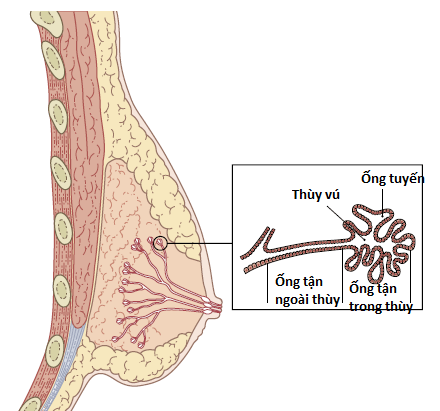
Mammary ductal ectasia (MDE) is a common breast problem. There are long debated questions besides this pathology. Is this some form of damage caused by an infection? Does dilated mammary gland cause breast cancer? Let's learn about this disease together and answer the above questions.
content
- 1. Introduction
- 2. Do mammary duct dilatation lead to cancer or not?
- 3. Symptoms
- 4. Treatment
- 5. Conclusion
1. Introduction
Ductal dilatation is a benign disease of the breast. As the name implies, this is the dilation of the terminal duct of the mammary gland.
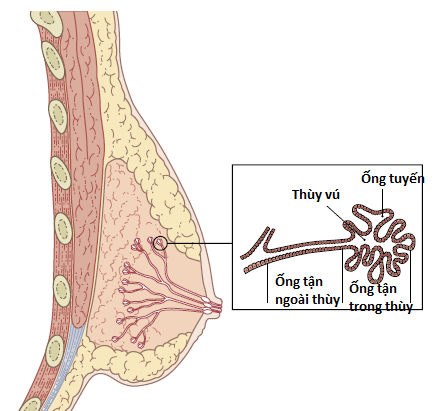
As shown in the picture, we can clearly see the preliminary structure of the breast. There are many lobes of the breast, in each breast lobe there are inner lobe ducts, outside is the outer lobe ducts that help carry milk from the lobes. The extralobular ducts lead to the larger ducts of the mammary glands, which eventually gather at the nipple.
Mild ductal dilatation (mild) is not pathological in nature. It's just a normal progression of women as they get older. But why do people sometimes talk about diagnosing, testing, even treating this supposedly “physiological” problem?
Because in many cases, ductal dilatation is often accompanied by inflammation around the dilated mammary ducts - periductal inflammation. Symptoms appear alternately, including abnormal discharge, breast pain, nipple retraction... All of the above problems are suggestive of a pathological lesion, even cancer.
Therefore, obstetricians and gynecologists must ask about the disease, examine it carefully, as well as give tests to rule out other diseases. From there, they can diagnose this as a physiological phenomenon of the patient.
Treatment is sometimes necessary, as an actual infection or malignancy may be present.
1.1. Presence of ductal dilatation
Ductal dilatation occurs in about 25% of women, and about 50% of them are women over 60 years of age.
As the data above, we can see, dilated mammary ducts seen mainly in women around menopause (about to and have gone through menopause). However, the condition can also occasionally occur in young women (30 years old), and even more rarely in girls and men.
Most cases (66%) of ductal dilatation are asymptomatic.
1.2. Why is ductal mastitis called periductal mastitis?
In some cases of dilated mammary glands, there is inflammation around the ducts. This will cause abnormal symptoms in the breast. Clinical symptoms of ductal dilatation in some cases are quite similar to periductal mastitis, sometimes even breast cancer.
>>> See more: Early warning signs of breast cancer every woman needs to know
There are even cases of peritubular mastitis in subjects with dilated mammary glands.
Therefore, one can use the terms ductal dilatation and peritubular mastitis interchangeably. However, this is only true in cases where the diagnosis is unclear. The final diagnosis before treatment must clearly distinguish these two problems.
Thus, in essence, these are 2 separate diseases.
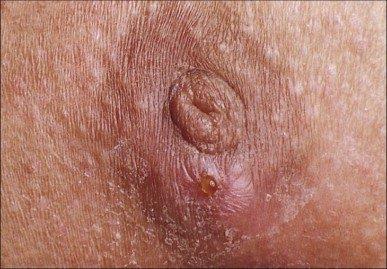
Periductal mastitis.
It is hypothesized that infection in peritubular mastitis leads to ductal dilatation. This has been proven wrong.
2. Do mammary duct dilatation lead to cancer or not?
As mentioned, its nature is a natural physiological phenomenon, completely unrelated to cancer progression. However, it is not excluded that breast cancer and dilated mammary ducts appear at the same time.
3. Symptoms
Interpreting each patient's symptoms and then aggregating them will show the most complete and accurate picture for each subject.
Dilated mammary glands have symptoms that are not specific or easily overlap with other diseases. Just as breast cancer is not an uncommon disease, so are mastitis and ductal enlargement.
Symptoms of ductal enlargement of the mammary gland are varied and vary from person to person. Therefore, the doctor's diagnosis and treatment will follow each specific symptom that the patient has.
>>> See more: Breast pain: Ten common causes
3.1. Unusual discharge from the nipple
80% of women experience this condition at least once in their lifetime. The condition can be very uncomfortable, especially when the discharge is unusually heavy or recurrent or persistent. The discharge can also panic the patient, especially when the discharge is red like blood.
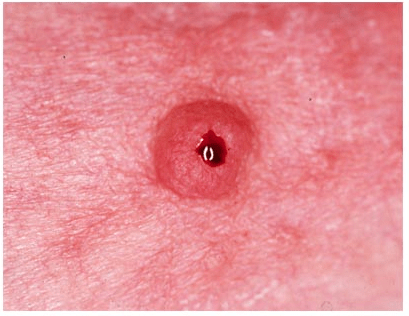
Nipples secrete thin blood.
Most nipple discharge is benign. However, up to 15% of cases are malignant.
Physiologically, mammary discharge is the most common manifestation of symptomatic ductal dilatation. The discharge color is usually: yellow, white, green, brown, blue - black. The discharge is usually thick, viscous, sometimes similar to toothpaste.
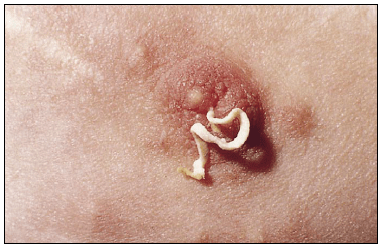
Nipples have a thick, paste-like discharge like toothpaste.
Signs of discharge leading to suspicion of breast cancer:
- Spontaneous discharge (no pregnancy, no trauma, no external stimuli).
- Discharge on one side.
- There is only one outlet of secretions.
- Bleeding like blood, thin water.
- Translated out continuously, prolonged.
When these signs are present, your doctor will perform imaging tests to check for cancerous lesions.
- Mammography.
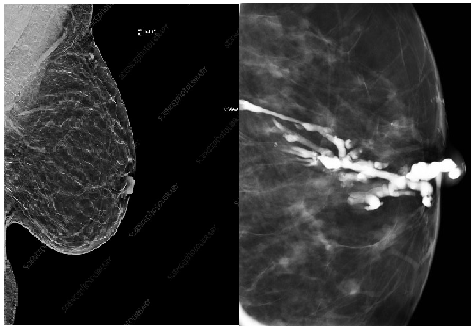
Left: Normal mammogram. Right: Mammogram with dilated mammary glands.
- Breast ultrasound.
- Sometimes, breast MRI, breast biopsy is necessary.
3.2. Breast pain
This symptom is classified into 3 groups:
- Due to extra-mammary causes (near the breast, not caused by the breast).
- Cyclic breast pain.
- Not cycle related.
In particular, breast pain caused by causes other than the breast is common such as:
- Herpes .
- Costochondritis.
- Local myocardial ischemia.
- Irritation of the pleura.
- Gastroesophageal reflux.
- Broken ribs.
Cyclic breast pain
Cyclic breast pain accounts for about 66% of cases, often related to changes in the patient's hormones. Typically, 1 week before menstruation, the patient will develop breast pain. Pain is usually in both breasts, can be severe, especially in the upper outer quarter of the breast.
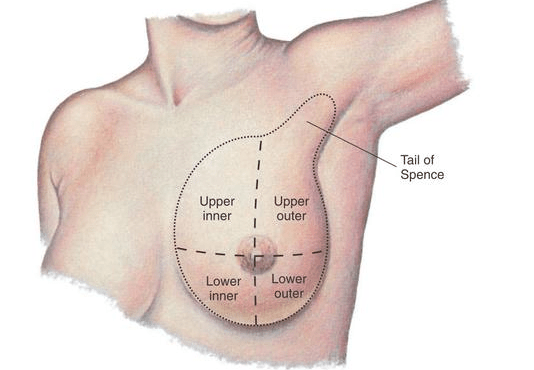
Upper inner: Upper inner breast. Upper outer: Above the breast. Lower inner: Lower in the breast. Lower outer: Below the outside of the breast.
In addition, cyclical breast pain may occur in patients using oral contraceptives.
>>> See also: Breast pain: Diagnosis, treatment and ways to relieve pain at home
Non-cyclical breast pain
accounted for 33% of cases. Ductal enlargement is one of the causes of non-cyclical breast pain. It is the inflammation around the breast that causes this symptom to appear.
Peritubal mastitis also causes breast pain, the main mechanism being inflammation. However, peritubular mastitis is usually caused by an infection.
These general mastitis conditions often have accompanying manifestations such as: swelling, heat, and redness of the breast. Occasionally, the patient may have a fever.
Because there are many causes, when a patient comes to the clinic because of breast pain, the doctor will examine the breast to answer the questions:
- Is the pain really due to a breast cause?
- Is it mastitis?
- Breast abnormalities suggestive of cancer such as: palpable lump, change in skin color in the breast, nipple oozing blood?
Since mastitis is common in this case, ultrasound is often the modality of choice. Depending on the case, it is possible to combine mammography or not.
3.3. Feel the lump in the breast
Understandably, there is a common fear among patients who feel/examine a lump in the breast. The question that must be answered for the patient is whether this is a benign or malignant tumor. 90% of breast lumps between the ages of 20 and 50 are benign.
>>> See more: Feeling a lump in the breast: What should I do?
In subjects with dilated mammary glands, breast tumors appear due to:
- Dilated tubes are palpable.
- Abcess due to peritubular mastitis.
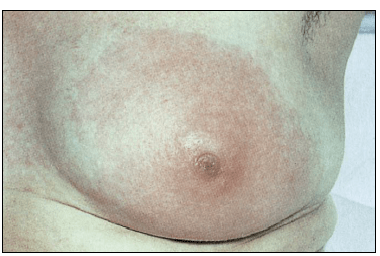
Abcess of the breast in peritubular mastitis.
When a patient presents with a breast lump, it is imperative that the doctor do a thorough examination and perform tests and/or procedures.
The preferred test for use in young women < 30="" age="" is="" super="" negative="" breast.="" view="" review="" breast="" photo ="" if="" difficult="" survey="" close="" on="" super="" negative.="" yes="" can="" use="" use="" birth= "" set="" core="" needle="" to="" mark="" price="" copy="" substance="" of="" block="" u="">
For women 30 and older, mammograms are often the first choice. Breast tumors will be graded according to the BI-RADS table.
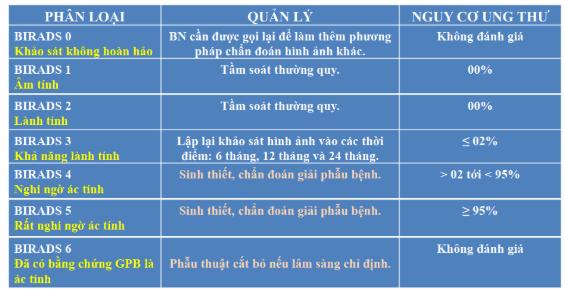
The BI-RADS grading is used in breast ultrasound, mammography and MRI.
3.4. The nipple is pulled inward
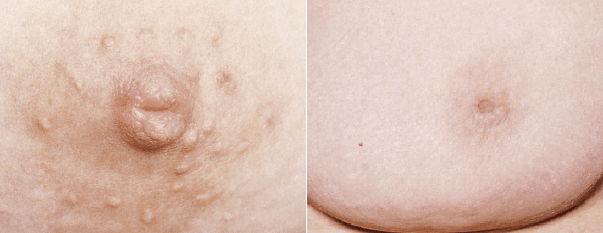
Left: The nipple is slightly pulled inward. Right: The nipple is fully pulled inward.
Conditions such as ductal dilatation, peritubular mastitis, breast abscess, and tuberculous mastitis can all cause inverted nipples. In addition, breast cancer also causes this condition. Nipple reduction can occur after breast reconstruction (cancer removal) or breast biopsy.
This symptom compels the doctor to perform breast ultrasound, mammography and breast biopsy when there is a suspected cancerous lesion.
Thus, it is easy to see that:
In patients with breast symptoms, the first thing the physician should rule out is malignancy.
4. Treatment
The main cases of ductal dilatation are treated symptomatically.
4.1. For nipple discharge symptom
Tea or coffee may help improve symptoms. However, the duration of treatment can be up to 6-9 months, and there are not enough studies to prove the benefit of this treatment.
4.2. Breast pain
Use Bromocriptin for treatment for 2 weeks, prolonged at low doses for 6 months if there is a relapse.
Antibiotics are only considered in cases of severe breast pain. Antibiotics of choice are metronidazole and flucloxacillin, which kill anaerobes and Staphylococci. Erythromycin is the second choice.
4.3. Surgery
Patients are indicated for surgical removal of dilated ducts when:
- Nipple discharge with milky white, colored, bloody or thin discharge.
- To pull the nipple out.
- Diagnosis of suspected breast tumor.
- Abscess.
- Leakage line.
- Eczema (caused by nipple discharge).
Causes of recurrent breast enlargement symptoms after surgery
- The abscess cavity still exists – not completely dissected.
- The dilated ducts near the nipple have not been cut.
- The distal duct is dilated but not removed.
5. Conclusion
Ductal dilatation is a common physiological process in older women. A ductal dilatation may be overlapping with an infection.
Although classified in the same group as peritubular mastitis, doctors sometimes confuse these two separate conditions with each other.
Peritubal mastitis occurs mainly in young women of childbearing age. And dilated mammary ducts are mainly caused by aging mammary ducts.
Diagnosis of ductal enlargement is usually based on breast ultrasound. The discovery of ductal dilatation is often accidental because most cases are asymptomatic.
When symptomatic, it is imperative to exclude associated breast cancer.
Treatment of dilated mammary glands is mainly symptomatic relief for the patient.
Doctor Nguyen Doan Trong Nhan